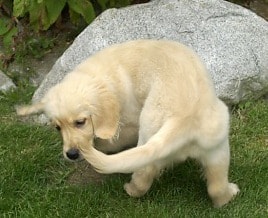Typically, a dog chases its tail simply since it really is pleased, excited and energetic and such behaviour is actually a normal component of play. This really is similar to the human behaviour of tapping fingers, or whistling. It really is a release of power, and doesn’t constantly mean one thing is incorrect, but it can do if a dog does it excessively or over-anxiously.
Some dog breeds do this far more than other individuals, but all dogs can display this behaviour at times, though it must not be a frequent occurrence in most dogs.

The owner may unwittingly encourage the behaviour as any attention can be interpreted by the dog as a positive reinforcer. The dog chases its tail. The owner tries to quit or distracts the animal. The dog finds the attention very rewarding and chases its tail much more.
Another reason a dog will chase its tail is by way of boredom. If the dog is left alone for lengthy periods or will not obtain sufficient workout it may chase its tail to rid itself of excess energy and this can be something, which can lead to be much more worrying problems or can even be a signal of one already present within the dog, for example, separation anxiety.
In rare circumstances, tail chasing could possibly be a sign of a neurological condition. Excessive tail chasing has been linked to psychomotor epilepsy.
Tail chasing is more frequent in certain breeds, for example, the Staffordshire Bull Terrier. This points to an achievable indication that there may be a hereditary pattern or predisposition to this activity. It may also be that particular sized dogs are more prone to it since the tail is in less complicated reach because of the size or flexibility from the breed, or indeed, the simple playful character of particular breeds.
It’s not typically one thing to be concerned about unless you can’t stop it occurring by channel ling the dog’s energy into something else like a toy. If in doubt you need to often seek specialist veterinary advice.
